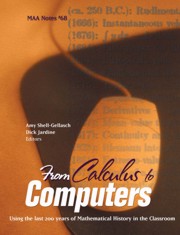Book contents
- Frontmatter
- Preface
- Contents
- Introduction
- I Algebra, Number Theory, Calculus, and Dynamical Systems
- II Geometry
- III Discrete Mathematics, Computer Science, Numerical Methods, Logic, and Statistics
- IV History of Mathematics and Pedagogy
- 16 Incorporating the Mathematical Achievements of Women and Minority Mathematicians into Classrooms
- 17 Mathematical Topics in an Undergraduate History of Science Course
- 18 Building a History of Mathematics Course from a Local Perspective
- 19 Protractors in the Classroom: An Historical Perspective
- 20 The Metric System Enters the American Classroom: 1790–1890
- 21 Some Wrinkles for a History of Mathematics Course
- 22 Teaching History of Mathematics Through Problems
- About the Authors
22 - Teaching History of Mathematics Through Problems
from IV - History of Mathematics and Pedagogy
- Frontmatter
- Preface
- Contents
- Introduction
- I Algebra, Number Theory, Calculus, and Dynamical Systems
- II Geometry
- III Discrete Mathematics, Computer Science, Numerical Methods, Logic, and Statistics
- IV History of Mathematics and Pedagogy
- 16 Incorporating the Mathematical Achievements of Women and Minority Mathematicians into Classrooms
- 17 Mathematical Topics in an Undergraduate History of Science Course
- 18 Building a History of Mathematics Course from a Local Perspective
- 19 Protractors in the Classroom: An Historical Perspective
- 20 The Metric System Enters the American Classroom: 1790–1890
- 21 Some Wrinkles for a History of Mathematics Course
- 22 Teaching History of Mathematics Through Problems
- About the Authors
Summary
Introduction
As teachers, we are always looking for ways to actively engage our students in the learning process. One approach in a history of mathematics course is to have students work on a historically motivated set of problems which are independent of the other requirements of the course. These problems are described, and the effects on the class are discussed.
In devising my history of mathematics course, I had in mind three goals. First, in addition to having a sense of how mathematics was developed, it is important that students see how mathematics is developed. A history of mathematics class seemed an excellent place for students to learn the process involved in creating mathematics. Second, the class should broaden the students' views of mathematics. In particular, they should see a significant amount of mathematics that is not motivated by geometry, algebra, or calculus. Third, they should understand that mathematics is a dynamic, live subject that has not all been done already. I still remember taking Calculus III, and thinking to myself, “How much more math could there be?” Hopefully, the students would not come out of this class thinking the same thing. To address these goals, I developed an extensive list of problems, and required students to spend at least three hours each week working on the problems between class meetings.
In general, the problems selected satisfy two criteria: They are easily stated, and they lead to mathematical ideas of historical importance.
Information
- Type
- Chapter
- Information
- From Calculus to ComputersUsing the Last 200 Years of Mathematics History in the Classroom, pp. 243 - 250Publisher: Mathematical Association of AmericaPrint publication year: 2005
